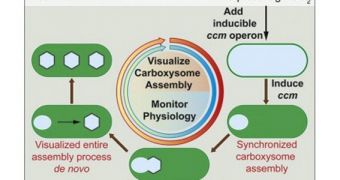For the first time ever, researchers at the US Department of Energy (DOE) Joint Genome Institute (JGI) were able to gain insight into how microorganisms called cyanobacteria use specialized structures in their cells to convert carbon from carbon dioxide molecules into fuel.
The process takes place inside tiny compartments called carboxysomes, where the chemical is fixed before conversion. Researchers have known for a long time that cyanobacteria can fix carbon, but the exact mechanism through which the substance was put to good use remained elusive.
But the thing that really baffled the researchers was that the bacteria constructed their carboxysomes in a manner not previously seen in any other plant, animal or eukaryotic cell. “The carboxysome, unlike eukaryotic organelles, assembles from the inside out,” says former JGI researcher Cheryl Kerfeld.
Details of the new research were published in the November 21 issue of the journal Cell. The paper describes carboxysomes as resembling viral envelopes, and featuring around 20 facets, each shaped like a triangle. Additional studies will most likely be needed to fully understand this structure.

 14 DAY TRIAL //
14 DAY TRIAL //